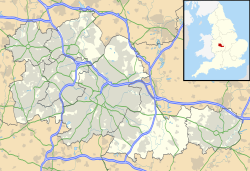| Charterhouse | |
|---|---|
 | |
Location within the West Midlands | |
| General information | |
| Status | Grade I listed |
| Town or city | Coventry |
| Country | United Kingdom |
| Coordinates | 52°24′03″N1°29′41″W / 52.4009°N 1.4947°W |
| Completed | 14th century |
| Owner | National Trust |
Charterhouse, Coventry (also known as St. Anne's Priory, Coventry) is a grade I listed building on London Road, Coventry, in the West Midlands of England. [1]
Contents
The current building incorporates remains from the charterhouse of St Anne, the foundation stone for which was laid in 1385 by King Richard II. It contains additions from the 15th and 16th centuries, as well as several wall paintings dating to the same era. It ceased operation as a monastery during the Dissolution of the Monasteries. [2] Some of the original window tracery still survives. It was used as a private home from 1848 to around 1940 when it was left as a centre for arts and culture. [3]
The Coach House and Medieval Precinct Wall to the Charterhouse form a group of listed buildings. [1] The Charterhouse itself is a grade I listed building, [1] the precinct wall is grade II* listed, [4] the coach house is grade II listed, and the whole site is a Scheduled Ancient Monument. [5] The site was on the Heritage at Risk Register due to problems with the roof. [6] After community action to save Coventry, the building it is now owned by the charity Historic Coventry Trust which seeks to regenerate the site, supported by grants from the National Lottery Heritage Fund and others.
The building was removed from the Heritage at Risk Register in 2022, [7] and opened to the public in April 2023. [8] In January 2025, Coventry City Council announced that a partnership with the National Trust had been formed to manage the site. [9]
The Charterhouse is on the banks of the River Sherbourne, Coventry's main river. A short distance away is the Sherbourne Viaduct, a railway bridge carrying the Coventry to Rugby railway line over the river. [10]
